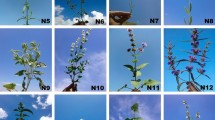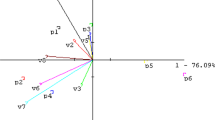Abstract
PROBABLY the most interesting of the large number of heartwood specimens previously examined1 on two-way paper chromatograms by the toluene-p-sulphonic acid reagent1,2 are the extractives of some of the species of the genus Guibourtia, previously known as Copaifera. Those extractives of Guibourtia coleosperma, G. tessmannii and G. demeusei which are soluble in methanol, for example, redden rapidly on exposure to direct sunlight and furnish high yields of anthocyanidins when treated with 3 N hydrochloric acid/propan-2-ol (1:5) under pressure3 (about 8 per cent yield) or under anhydrous conditions with N/40 hydrochloric acid4 (about 13 per cent yield). These extractives may be fractionated into a high proportion of tannins insoluble in water and with an average molecular weight of about 2,200, and a low proportion of polyphenols and carbohydrates soluble in water. Examination of the latter fraction with the toluene-P-sulphonic acid spraying reagent on two-way paper chromatograms shows the probable presence of flavan-3.4-diols with R F values corresponding to 0.45–0.55 in 2 per cent acetic acid (second irrigant), but with differing R F values in the partitioning mixture used (butan-2-ol saturated with water: first irrigant)5.
This is a preview of subscription content, access via your institution
Access options
Subscribe to this journal
Receive 51 print issues and online access
$199.00 per year
only $3.90 per issue
Buy this article
- Purchase on Springer Link
- Instant access to full article PDF
Prices may be subject to local taxes which are calculated during checkout
Similar content being viewed by others
References
Roux, D. G., and Evelyn, S. R., Biochem. J., 69, 530 (1958).
Roux, D. G., Nature, 180, 973 (1957).
Pigman, W., Anderson, E., Fischer, R., Buchanan, M. A., and Browning, B. L., Tech. Assoc. Pulp and Paper Indust., 36, 4 (1953).
Roux, D. G., Nature, [183, 42 (1959)].
Roux, D. G., and Evelyn, S. R., J. Chromatography, 1, 537 (1958); Biochem. J., 70, 334 (1958).
Keppler, H. H., J. Chem. Soc. (Japan), 2721 (1957).
Mitsuno, M., and Yoshizaki, M., J. Pharm. Soc. (Japan), 77, 557, 1208 (1957).
Bate-Smith, E. C., and Westall, R. G., Biochim. Biophys. Acta, 4, 427 (1950). Bradfield, A. E., and Bate-Smith, E. C., ibid., 4, 441 (1950).
Freudenberg, K., Karimullah, and Steinbrunn, G., Ann. Chem., 518, 37 (1935).
Freudenberg, K., and Roux, D. G., Naturwiss., 41, 450 (1954); Ann. Chem., 613, 56 (1958).
Roux, D. G., Chem. and Indust., 161 (1958). Freudenberg, K., and Weinges, K., Ann. Chem., 613, 61 (1958).
Author information
Authors and Affiliations
Rights and permissions
About this article
Cite this article
ROUX, D. Flavan-3.4-diols and Leuco-anthocyanidins of Guibourtia spp.. Nature 183, 890–891 (1959). https://doi.org/10.1038/183890a0
Issue Date:
DOI: https://doi.org/10.1038/183890a0
This article is cited by
Comments
By submitting a comment you agree to abide by our Terms and Community Guidelines. If you find something abusive or that does not comply with our terms or guidelines please flag it as inappropriate.



